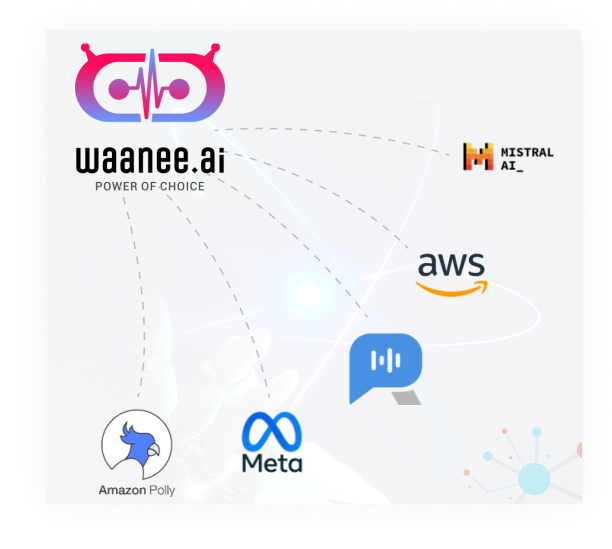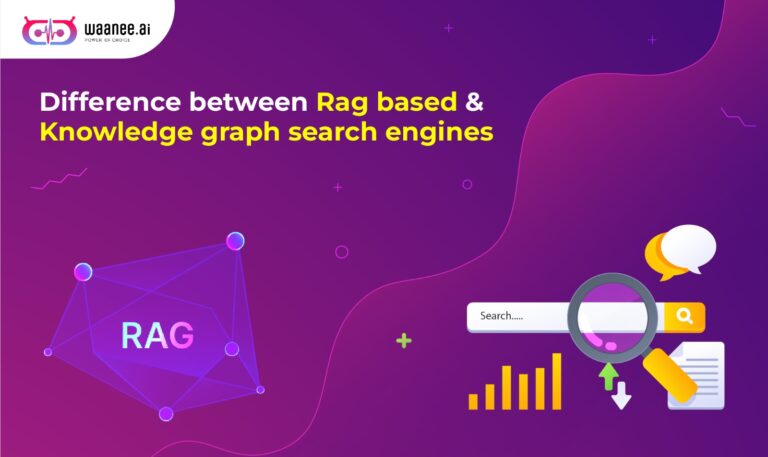
-
Waanee AI Labs
View All »

Get The Latest
Detecting Fraud Patterns Through Voice Conversations in Real Time
Read More »Will AI Replace Call Center Agents? The Truth About Virtual Assistants and Human Collaboration
Read More »Transforming Contact Centers with Waanee AI's Agentic Framework
Read More » - Blog
Difference between Rag based & Knowledge graph search engines
Posted by Vishal Vanwari, on 30 Sep, 2024 07:41 AM

In the dynamic realm of information retrieval, two revolutionary technologies are reshaping how we find and interact with data: Retrieval-Augmented Generation (RAG) based search engines and Knowledge Graph search engines. Both aim to enhance the quality and relevance of search results, but they approach this goal in fundamentally different ways. This blog post will delve into the distinctions between these two technologies, their strengths, limitations, and their impact on the search industry.
RAG-based Search Engines: Bridging the Gap Between Retrieval and Generation
Retrieval-Augmented Generation (RAG) is a relatively new approach that combines the power of large language models (LLMs) with traditional information retrieval techniques. RAG-based search engines work by first retrieving relevant documents from a corpus and then using an LLM to generate a response based on the retrieved information.
How RAG Works:
- Retrieval: When a user submits a query, the system searches through its document database to find the most relevant pieces of information.
- Augmentation: The retrieved documents are then fed into the LLM as context.
- Generation: The LLM generates a response based on the query and the provided context.
Advantages of RAG:
- Up-to-date Information: RAG can access the latest information in its database, making it suitable for dynamic content.
- Reduced Hallucination: By grounding the LLM’s responses in retrieved documents, RAG significantly reduces the likelihood of generating false or hallucinated information.
- Flexibility: RAG can handle a wide range of queries, from factual questions to more complex, open-ended inquiries.
According to a 2023 study by Stanford University, RAG-based systems showed a 37% improvement in factual accuracy compared to standalone LLMs across various domains.
Knowledge Graph Search Engines: Connecting the Dots
Knowledge Graph search engines, on the other hand, rely on structured representations of information and the relationships between entities. These search engines use graph databases to store and query interconnected data points, allowing for more contextual and relationship-based search results.
How Knowledge Graphs Work:
- Entity Extraction: Information is organized into entities (people, places, things) and their attributes.
- Relationship Mapping: Connections between entities are established and stored.
- . Query Processing: User queries are interpreted and matched against the graph structure to find relevant entities and relationships.
Advantages of Knowledge Graphs:
- Contextual Understanding: By representing relationships explicitly, Knowledge Graphs can provide more nuanced and context-aware results.
- Semantic Search: Users can find information based on meaning and relationships, not just keyword matches.
- Data Integration: Knowledge Graphs excel at integrating diverse data sources into a unified structure.
A 2022 report by Gartner predicts that by 2025, graph technologies will be used in 80% of data and analytics innovations, up from 10% in 2021, highlighting the growing importance of Knowledge Graphs in the search landscape.
Comparing RAG and Knowledge Graph Approaches
While both technologies aim to improve search results, they have distinct characteristics that make them suitable for different use cases:
Use Cases:
– RAG: Excels in scenarios requiring natural language understanding and generation, such as question-answering systems, chatbots, and research assistants.
– Knowledge Graphs: Shine in applications needing complex relationship analysis, such as fraud detection, recommendation systems, and scientific research.
Scalability:
– RAG: Can handle large volumes of unstructured data but may face challenges with real-time updates due to the computational demands of LLMs.
– Knowledge Graphs: Highly scalable for structured data and can handle real-time updates efficiently.
Accuracy and Explainability:
– RAG: Provides natural language responses but may struggle with explainability. The “black box” nature of LLMs can make it challenging to trace the reasoning behind a given answer.
– Knowledge Graphs: Offer high explainability as the paths between entities are explicit and can be visualized. This makes them particularly valuable in fields like healthcare and finance where decision transparency is crucial.
A 2023 survey by O’Reilly found that 78% of organizations using Knowledge Graphs reported improved decision-making capabilities, compared to 62% for those using traditional search technologies.
Industry Impact and Future Trends
The search engine market is rapidly adapting to these new technologies. Google, for instance, has been using Knowledge Graph technology since 2012, which has significantly enhanced its ability to provide direct answers to user queries. According to Google, their Knowledge Graph contains over 500 billion facts about 5 billion entities, demonstrating the scale at which this technology can operate.
On the RAG front, OpenAI’s GPT-4 has shown impressive capabilities in augmenting its responses with external knowledge. A 2023 benchmark study revealed that RAG-enhanced GPT-4 outperformed traditional search engines by 28% in complex query understanding and response generation.
Looking ahead, we can expect to see increasing integration of these technologies:
Hybrid Systems: Combining the strengths of both RAG and Knowledge Graphs to create more powerful and versatile search engines.
AI-Powered Graph Construction: Using machine learning to automatically build and maintain Knowledge Graphs from unstructured data.
Personalized Search Experiences: Leveraging user context and preferences to tailor search results using both RAG and Knowledge Graph technologies.
Conclusion
RAG-based and Knowledge Graph search engines represent two powerful paradigms in the evolution of information retrieval. While RAG excels in natural language processing and handling unstructured data, Knowledge Graphs provide unparalleled capabilities in representing and querying complex relationships. As these technologies continue to mature and converge, we can expect even more sophisticated search experiences that combine the best of both worlds, ultimately leading to more intelligent, context-aware, and user-centric information discovery systems.
The choice between RAG and Knowledge Graph approaches—or a combination of both—will depend on the specific needs of the application, the nature of the data involved, and the desired user experience. As organizations strive to make sense of ever-increasing volumes of data, these advanced search technologies will play a crucial role in unlocking the full potential of our collective knowledge.
READ ALSO...
Detecting Fraud Patterns Through Voice Conversations in Real Time
03 Jul, 2025 11:09 AM
Will AI Replace Call Center Agents? The Truth About Virtual Assistants and Human Collaboration
19 May, 2025 11:30 AM
Transforming Contact Centers with Waanee AI's Agentic Framework
25 Feb, 2025 01:52 PM
Revolutionize CX
with AI power
Delivers personalized interactions and immediate, data-driven solutions powered by AI, transforming customer experiences.

We use cookies!
We use cookies to ensure that we give you the best experience on our website.
By continuing to use this site, you accept our use of cookies. Learn more
 Recruit Industries Agents
Recruit Industries Agents Build Your Agent
Build Your Agent Improve Self Service
Improve Self Service Employee Experience
Employee Experience Sales and Cross Sales
Sales and Cross Sales Calling Script
Calling Script Integration & APIs
Integration & APIs Auto Summarization
Auto Summarization Conversational Intelligence
Conversational Intelligence Sentiment Analytics
Sentiment Analytics Auto QA
Auto QA Net Promoter Score
Net Promoter Score